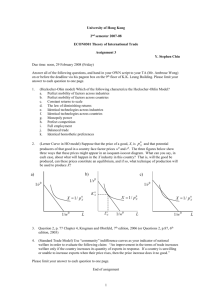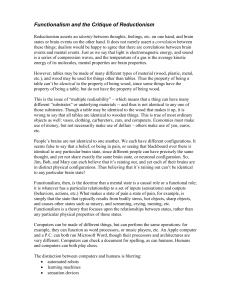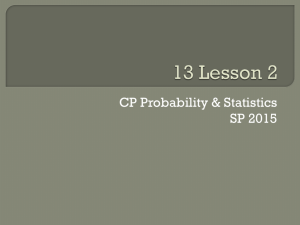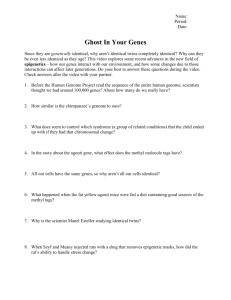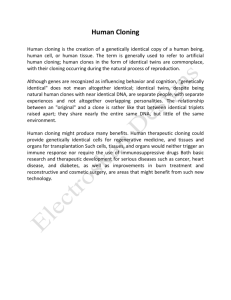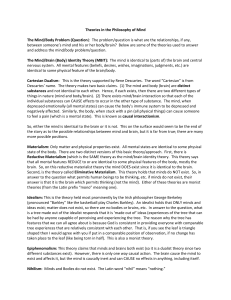Procedures
advertisement
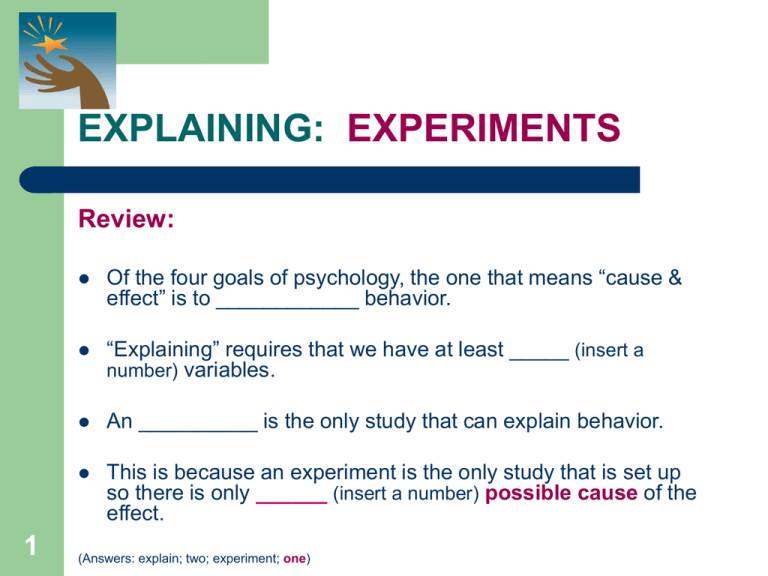
EXPLAINING: EXPERIMENTS Review: 1 Of the four goals of psychology, the one that means “cause & effect” is to ____________ behavior. “Explaining” requires that we have at least _____ (insert a number) variables. An __________ is the only study that can explain behavior. This is because an experiment is the only study that is set up so there is only ______ (insert a number) possible cause of the effect. (Answers: explain; two; experiment; one) EXPLAINING: EXPERIMENTS 2 The study that is done to explain is called an experiment. However, it’s only legitimate to call a research study an experiment if it follows several principles, rules and procedures. By the end of this show, you should be able to describe and explain the rules, principles and procedures. EXPLAINING: EXPERIMENTS An Introduction to the MAIN PRINCIPLE Underlying an Experiment: An experiment is the only type of study that eliminates all variables, except one, that might influence the effect. In other words, the procedures in an experiment get rid of all possible causes of an effect, except the one we are trying to study. * The complete version will be on slide 12. 3 EXPLAINING: EXPERIMENTS Three Rules that Help Us Eliminate Unwanted Variables: To make sure there is only one variable that might cause the effect, the experimenter (or assistants) must be the one who – – – literally creates two (or more) identical groups of participants, determines which group of participants gets which amount of the variable we think is causing the effect, and creates & maintains an environment where there is only one difference (the cause) between groups. * Remember, cause & effect refers to the Goal called Explaining. 4 EXPLAINING: EXPERIMENTS A Sample Study – My Hypothesis 5 Typically, sports teams are more likely to win if they play in their own city, their own stadium. It’s often said this is because their fans are there to cheer them on. Let’s say I want to test the idea that “cheering fans” are the cause of the home team advantage (the effect). EXPLAINING: EXPERIMENTS A Sample Study – Following the Rules & Procedures 6 In my hypothetical experiment, I’m going to make two sets of clones of your favorite football team. For each of the two clones (per player) I’m going to have them choose straws out of a hat. There will be one short straw and one long straw for each pair. If the person gets the short straw, he will be on Team #1 and a long straw means Team #2. EXPLAINING: EXPERIMENTS A Sample Study – Continued I will create two identical football stadiums, and identical cloned fans. In Stadium 1, Team #1 will play, and I will ensure that half the cloned fans will be there and will cheer them on. In Stadium 2, Team #2 will play for the other half of the clones. This time, though, I will not allow the fans to cheer. I will then see which team wins. (I’m measuring the “effect”.) 7 EXPLAINING: EXPERIMENTS NOTICE: I MET THE FIRST RULE: I must create two identical groups. 8 I personally split the clones into the two teams, and I did it in such a way that they were exactly the same as each other. EXPLAINING: EXPERIMENTS NOTICE: I MET THE SECOND RULE BY FOLLOWING TWO PROCEDURES: 1. I personally created identical environments. Both teams had the same crowds, (except for the cheering) and the stadiums were the same. 2. I further kept out extra variables when I personally decided which team would have a cheering crowd. When I choose, I keep the teams from choosing. Later, we’ll discuss how this eliminates unwanted possible causes. 9 Vocabulary: If the experimenter actually creates the difference (in the variable we think is causing something to happen), that difference/variable is called the independent variable (i.v.). EXPLAINING: EXPERIMENTS REMINDER: 10 Only if these three procedures are followed should we refer to the study as an experiment. Why? Because only if these procedures are followed do we rule out variables that might produce an effect. EXPLAINING: EXPERIMENTS Why Do We Need to Rule Out Extra Variables? 11 If there is more than one initial difference between groups, we won’t know which difference produced any effect we may later discover. For example, if Stadium 1 had been colder than Stadium 2 and Team #1 had won, we wouldn’t know if they won because of the temperature or because of the cheering. EXPLAINING: EXPERIMENTS THE COMPLETE VERSON OF THE MAIN POINT: 12 An experiment is the only type of study that eliminates all variables (except the independent variable) that might affect the outcome. Therefore, if the two groups later differ on the “effect”, we know it has to be because of the i.v. because there is no other option. This is why an experiment is the only type of study that can tell us about cause & effect. Vocabulary: The “effect” is called the dependent variable (d.v.); its amount is dependent on how much of the i.v. there was. Creating Identical Groups Definitions: Identical groups 1. Two (or more) groups that are the same as each other with regards to the types of people making up the groups. 2. Two (or more) groups of people where the groups are identical to each other regarding any possible personal variable we could think of. 13 Hmmm….. How Do We Get Identical Groups? 14 We can’t really clone people. Where are we going to find many, many sets of twins that we can separate into 2 groups so the two groups are identical to each other? CAN WE ONLY DO EXPERIMENTS ON TWINS? Creating Identical Groups – The Difficult Way 15 Well, no. I suppose instead we could get two females and put one in each group. Then the groups would have identical numbers of females. But, what if one female was shy and the other wasn’t? Then the groups differ on “shyness.” Creating Identical Groups – The Difficult Way 16 Okay, now our groups differ on shyness. What can we do about that? I guess we could get four females, two who are shy and two who are not. We could put one of each in each group. That is, in Group #1, we’d have one shy & one not shy female, and in Group #2, we’d have one shy & one not shy female. Creating Identical Groups – The Difficult Way But then, what if only one of them has kids? The groups wouldn’t be equal anymore. REVIEW: Explain why we don’t want parents in one group but not in the other. _____________ ____________________________________. 17 Creating Identical Groups – The Difficult Way 18 But what if our first group has a female who is Catholic and diabetic but our second group does not? YIKES!!! There must be an easier way to create identical groups!!! Creating Identical Groups A MNEMONIC Have you noticed the picture in the right hand corner of the last few slides? Can you think of another name for a donkey? (If English isn’t your first language, you may need to ask someone.) 19 Shhh…. Don’t say it out loud! Write it down the other word: __________. Yes! This IS related to identical groups! (donkey) Creating Identical Groups: Use Random Assignment To create identical groups, we will use a procedure called random assignment. (We will think about donkeys so we don’t confuse random assignment with random selection. If you confuse them on assignments or tests, you will lose points.) 20 Here – let’s practice getting it right: To get identical groups, we will use random _____ignment. (donkey) Creating Identical Groups – Use Random Assignment Definition: RANDOM ASSIGNMENT 21 – After we know which people will be in the experiment, we divide them into the two groups using some method of chance (randomly). For example, we could flip a coin. “Heads – you’re in group A”. “Tails – you’re in group B.” – This procedure is called Random Assignment. Creating Identical Groups: Use Random Assignment 22 VERY IMPORTANT POINT If we want to know about cause & effect, random assignment is a crucial procedure for creating identical groups. This is because random assignment creates two groups that are identical on their personal characteristics and histories (theoretically, at least). How Does Random Assignment Create Identical Groups? Consider this: When we choose using “heads or tails”, we would expect half the participants to get heads and half to get tails. So, we are required to assume that – – 23 half the females were assigned to one group and half were assigned to the second group. half the males were assigned to the first group and half to the second group. So, now the two groups are identical with regards to “sex.” Then, if the two groups differ on the outcome (the d.v.), we know it can’t be because of “sex”, since “sex” was made constant across the two groups. (In other words, it didn’t vary.) How Does Random Assignment Create Identical Groups? continued This means all personal qualities such as age, shyness, hormone levels, town grown up in, number of good teachers previously taken, right vs. left handed, level of ADHD, GPA, frequency of drinking water, amount of serotonin, type of car driven, age of first kiss, level of shyness etc. etc. etc. cannot be the cause of a change in the dependent variable. 24 (Yes, I know…. You may be thinking that in real life, coins don’t always come up heads half the time and tails half the time. This is true, and after every experiment is finished, the results are analyzed with sophisticated statistics that take this into account. I will not be asking you to remember this. It’s just to satisfy your curiosity.) 25 Remember this really important main principle? If we have two identical groups who differ only on the independent variable and if we find a difference when we measure the dependent variable (d.v.), the only possible explanation for the d.v. being different between groups is ____________________ ___________________________. (You fill it in. If you can’t, you’re missing the main point, so go back over the material.) 26 Creating Identical Groups: Use Random Assignment IMPORTANT POINTS: Remember, creating identical groups with random assignment rules out unwanted “personal” variables as potential causes of the dependent variable. If a study does not use random ___ignment, we know with certainty that it has not ruled out multitudes of variables that could affect the d.v. 27 Since identical groups, and thus no unwanted variables, are essential if we are to know about cause and effect, random ____ignment also is essential. Creating Identical Groups: Random Assignment 28 Without random ____ignment, a study is not a true experiment. Identical Groups – Another Required Procedure IMPORTANT POINT 29 After using random assignment, to keep the groups identical they must be treated identically, except with regards to the independent variable. Research & Goal #3 - Explaining EXPERIMENTS Identical Groups REWORDING THE MAIN POINT Because a study should only be called an experiment if groups are identical (other than the i.v.), and because having identical groups rules out other possible causes that might affect the d.v., an experiment is the only type of study that can explain. 30 On a Different Note: Random Selection 31 Random Selection can be used with any type of study. Random selection often is not used because it can be difficult, or we may have little choice regarding who will be in our study. Random selection is irrelevant for testing cause & effect. Random Selection 32 Poor Ole’ Random Selection. It tells us absolutely nothing about cause and effect. What it is good for is giving us participants who represent the group of people we are trying to understand, called the population. Random Selection - Definition 33 Random Selection is using some method of chance to choose the people who will be participants in the study. IF Random Selection is used in an experiment, it is done before random assignment. This is because random assignment cannot be done unless we already know who will be in our experiment. Random Selection 34 Random Assignment Group 1 35 Group 2

